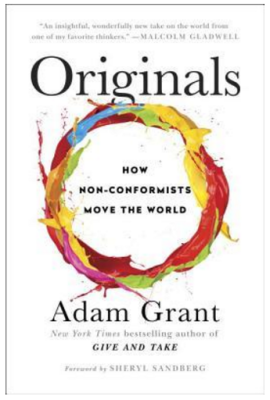Originals – Adam Grant

An another amazing book by Adam Grant, author of Give and Take. What I love best about books like this is how they give us a vocabulary to talk about concepts with which we are familiar but which are not easily condensed into shorthand terms we recognize.
“Pioneers & Settlers” contrasts the benefits of being first with being better. “Being original doesn’t require being first. It just means being different and better.”
“Young Geniuses & Old Masters” contrasts conceptual thinkers who may peak early with experimental thinks who may bloom late. There is no formula for being original.
There is also a fair amount of time spent on procrastination. And it’s not all bad! “Procrastination may be the enemy of productivity, but it can be a resource for creativity.” He goes on to outline examples of those who have used procrastination effectively, including Leonardo Da Vinci (the Mona Lisa and Last Supper) and Martin Luther King, Jr. as it relates to his “I Have a Dream” speech. “Procrastination turns out to be a common habit of creative thinkers and great problem solvers.
One of the most remarkable sections of this book is titled “The Narcissism of Small Differences” and went into a deep dive about the Suffragist Movement from 1855 to 1918. Grant examined the hurdles faced by the early pioneers – Lucy Stone, Susan B. Anthony and Elizabeth Cady Stanton. They were together, then splintered, aligning themselves with other advocates and movements. It was a tumultuous period and a history we need to understand. Such “small differences” are felt within groups – not nearly so strongly between disparate groups. Coalitions, collaborations and alliances are critical to movements and seismic change and we have to recognize how to align interests and groups to be more effective.
An interesting footnote to the Suffragist chapter: “Before the Nineteenth Amendment to the Constitution gave women full voting rights, 81 percent of Western states and territories passed suffrage laws, compared with two in the East and zero in the South.” I live in Virginia. We haven’t pass the ERA. We need to understand the history of that hurdle.
In a wonderful chapter on business case studies, Grant compares Polaroid with Bridgewater Investments in looking at culture and the affect of originals and original thinking in business organizations. “If you’re going to build a strong culture, it’s paramount to make diversity one of your core values. This is what separates Bridgewater’s strong culture from a cult: The commitment is to promoting dissent. In hiring, instead of using similarity to gauge cultural fit, Bridgewater assesses cultural contribution.” As relates to the “Devil’s Advocate” (a term I have never liked), a distinction is made between assigning someone to play that role and unearthing a genuine dissenter. “Whereas people doubt assigned dissenters, genuine dissenters challenge people to doubt themselves.”
A familiar axiom in business is “Don’t bring me problems, bring me solutions.” Grant takes issue with that widely embraced notion noting that “[David] Hofmann found that a culture that focuses too heavily on solutions becomes a culture of advocacy, dampening inquiry. If you’re always expected to have an answer ready, you’ll arrive at your meetings with your diagnosis complete, missing out on the chance to learn from a broad range of perspectives.” He cites this as one of the reasons NASA missed the possibility that the Space Shuttle Columbia might have a problem on re-entry – dissenting voices were shut down.
Another concept I really liked was the idea of ranking solutions rather than simply identifying “the best” one. Psychologist Andrea Hollinghead “finds that when groups are instructed to rank order alternatives, instead of choosing the best alternative, they’re more likely to consider each option, share information about the unpopular ones, and make a good decision.” Management scholar Karl Weick advises us to “Argue like you’re right and listen like you’re wrong.” Excellent!
I particularly loved Chapter 8 “Rocking the Boat and Keeping It Steady.” Here Julie Norem contrasts strategic optimism and defensive pessimism. There is something to be said for how we handle our emotions and recognize the benefits of better managing fear, excitement and calm. When we turn fear into excitement, we hit the “go switch.” I can see the value of that in many situations.
This chapter also spends time delving into the non-violent resistance training done during the Civil Rights movement to manage fear and anger. “Research demonstrates that when we’re angry at others, we aim for retaliation or revenge. But when we’re angry for others, we seek out justice and a better system. We don’t want to punish; we want to help.” That is sage advice for motivating those within any movement. It’s a strategic use of empathy.
Adam Grant has set up a self test so anyone can gauge their originality at http://AdamGrant.net I highly recommend the book. I believe that no matter how original you think you are, there are insights here that benefit everyone and every organization.